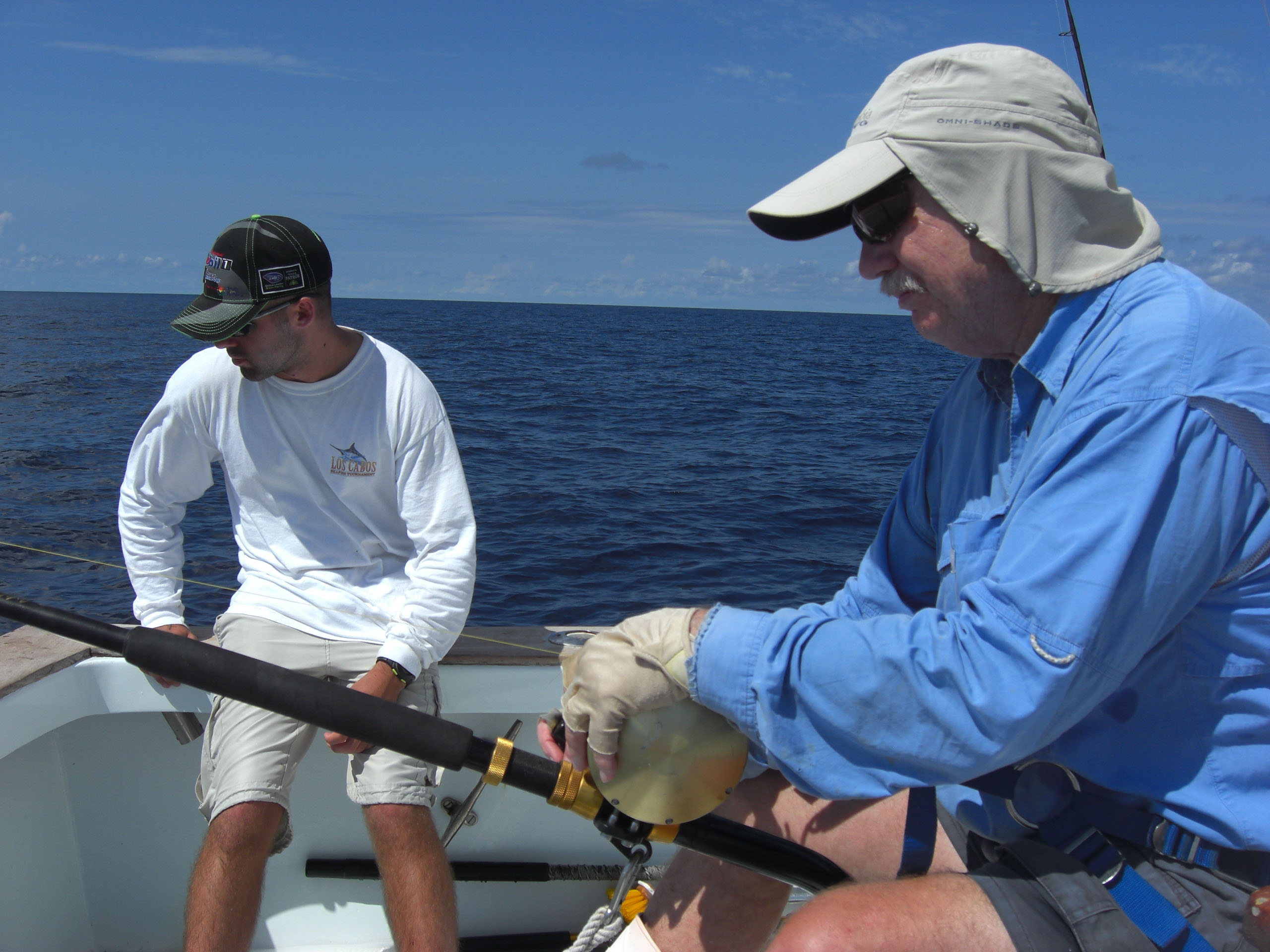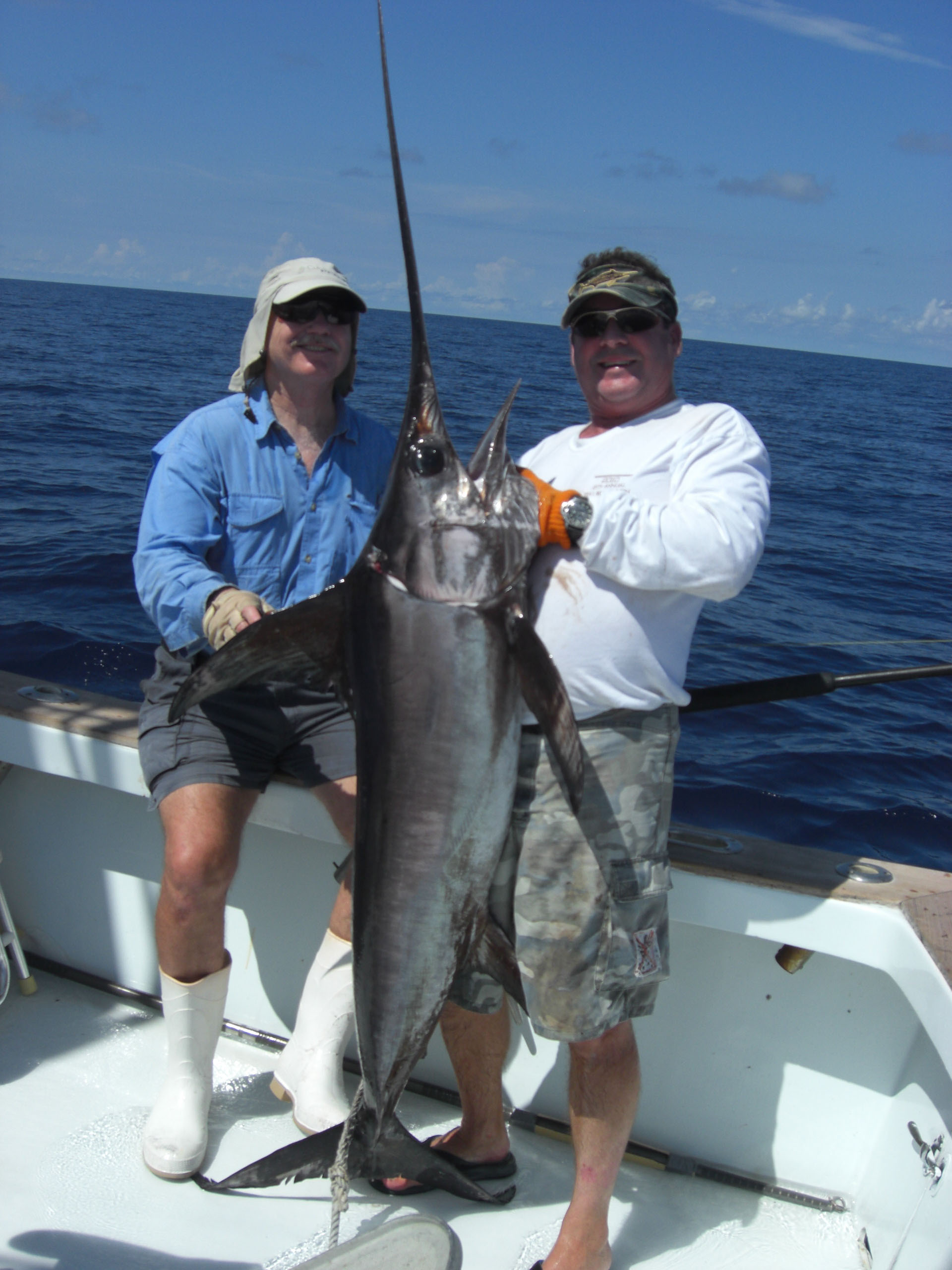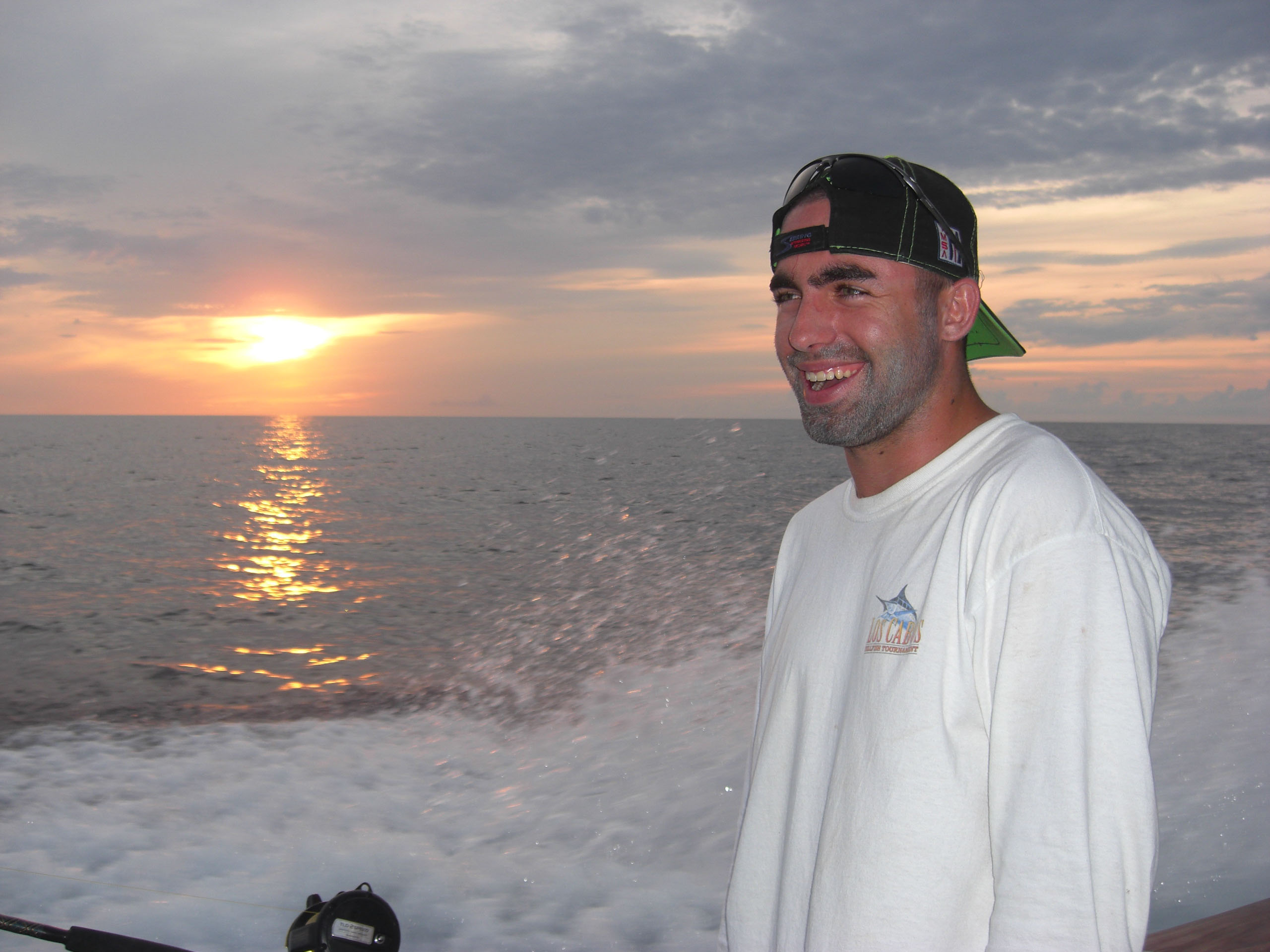|
Take a look at the short video showing the last 30 seconds of the fight to bring a 100lb Sword aboard the B&M.
Daytime Swordfishing You will also find great offshore fishing, reef fishing, and back country fishing (Tarpon, Bonefish, & Permit) at Bud & Mary's with one of 45 professional guides working out of there. Vic Gaspeny on one of 186 Swordfish taken Myself and Vic with his #185 My son Dylan grinning after a great day fishing I had the privilege last week to take my son Dylan out Daytime Swordfishing with the boys at Bud & Mary's Marina in Islamorada, more specificaly, Richard Stanczyk (the owner of Bud & Mary's), Vic Gaspeny (who has now angled 186 Swordfish to the boat), and Hunter, the mate on the Catch 22. Richard has literally pioneered this relatively new method to catch a great sportfish that has the added benefit of being extremely good table fare. We went on the B&M, Nick Stanczyk's 35' Crusader which is well suited for this type of fishing. Richard had invited Dylan and myself swordfishing around a year ago and I decided to take him up on it now as Dylan is going to Navy Basic Training in just 11 more days. I was mated for Richard on his charter boat during the years 1985 - 1987 making me fortunate enough to draw such an invitation. We had an amazing trip. At the beginning of the trip, Vic had already angled 181 Swords and 12 hours later, his number had risen to 186. We ended up releasing two that were small and keeping three between 75 and 100 lbs each. There are many intracasies and knowledge that were employed by this team that was learned Swordfishing over many years. I am surprised that Richard has encouraged me to divulge all of what I learned without fear for my life (or no more invitations), as he is hopeful that this new fishery will be something positive for the business of sportfishing creating another good reason to buy: tackle, gear, electronics, boats, fuel, that will help many people sustain there businesses in this slow economy. Please take this information in good faith that you will not employ these techniques to exploit the fishery for profit, but for sport, and table fare for the family and friends. The information I will share with you below will get you started with confidence that you will have a decent shot at hooking and landing a Swordfish, possibly on your first time out. We left the dock early in the AM and headed out to deep water. We trolled a Tormenter Black & Red Super Smoker while running, but found no Wahoo. Strangely enough, we did hook & catch a 22lb Dolphin on it though when we slowed down to pitch a bait to the Dolphin I spotted in the water. I had my son reel in the rig to get it out of the way when the fish jumped on it (after ignoring a fresh squid). After some discussion we set up on a spot that had previously produced fish for this team of experts. We were in around 1500 feet of water and I noticed on the chart plotter a corner in the shelf where the depth rose up to 1200 feet. We were right in that corner with a shelf on two sides of us and deep water on the third side of the "triangle". We fished in five or six different spots that were around a mile or two apart. We fished mostly beteen 1400 and 1700 feet. The thing in common between locations was that there was usually a drop off of some sort and the team felt that the fish were cruising these drop offs looking for bait. We fished a single 80 wide with bent butt spooled with 80lb braided line. We used wind-on leaders that appeared to be 300lb mono. There was a single use leader around five feet long spliced with a barrel swivel to the wind-on leader. There was a small light around five feet from the bait that was snapped onto the barrel swivel. This light was yellow or white and was bliking. We used concrete weights that were around 12 - 15lbs. These concrete weights were fitted (when being deployed) with an 80lb test drop line that was 40' long so that the weight would rest next to the bottom and the bait would be suspended well above the bottom. We tied a loop using a Spider Hitch at the end of the drop line that would attach to the breakaway using an electrical tie wrap. There was a larger light (blinking blue & red) around 30' from the hook attached near the splice from leader to braid. This was snapped to a strong rubber band that was attached to the main line with a waxed thread loop. Around 85' from the hook, the 15lb weight was attached to the break away line (and the 40' drop line) At this same location, there was a two pound lead weight secured the same way as the larger light with a waxed thread loop and a strong rubber band. The 2lb lead was used to keep the bait in the approximate proper depth in case the larger weight broke off prematurely. Sometimes the decision was made to intentionally break away the large weight so that they could feel the fish eating better, and even effect a proper drop back. Two of our fish were gut hooked proving the drop back will work. To attach the breakaway line, there will be two waxed thread loops around 18" apart (85' from the hook). You will tie these two loops together (around 6" apart) with a piece of doubled 20lb mono (the breakaway). You will tie wrap (electrical tie) the 80lb drop line for the 15lb weight to this breakaway. When your fish pulls hard enough to break the doubled 20lb, your large weight will break away. The bait was squid. It was tied to the hook to prevent it from being taken easily. We used both single and double hook rigs with equal success. First lay the bait and the small light in the water and let out the leader. Snap on the large light at the waxed thread loop dedicated and let out line until you reach the next set of loops for the weights. There will be two loops here around 18" apart. You will tie these two loops together (around 6" apart) with a piece of doubled 20lb mono (the breakaway). You will tie wrap (electrical tie) the 80lb drop line for the 15lb weight to this breakaway. At the time you are ready to free spool the reel to drop the line, toss the 8lb concrete weight away from the main line so it does not tangle with it. Let the main line out slowly until you feel the heavy weight and then allow the line to go out faster. Dropping the line was pretty basic similar to almost any type of bottom fishing. Slow enough not to tangle, but quick enough to get it to the bottom in a short period of time. It is best to pull away from the bait a bit while dropping to keep the leader from wrapping around the main line during the drop. The line was marked at 1500 feet, 1200 feet, 500 feet, and 200 feet so that the team knew approximately how far they had dropped a line and how close a fish was getting. We kept our weight off of the bottom and it seemed that we kept it around 10' - 60' up most of the time. Each time we dropped it seemed as though the bites were instantaneous. This did not mean that we were hooked up instantaneously as there was much toying back and forth between angler an fish in order to get the fish to commit to eating the bait and to convince the angler that the Swordfish had indeed eaten the bait. You will need to figure out this dance alone, but be informed that the dance does usually occur. Sometimes this lasted for ten minutes or more. The bites were slight, and even this team of experts sometimes debated whether or not the last bump was actually a bite or the sinker bouncing on the bottom. There were times when it was debated as to whether or not we were fighting a weight or a fish as when it is 1500 feet away the definition in the fish's movement was not clear. With one fish in particular, the debate went on almost until we actually saw the fish, as he started to jerk his head when he was around 200 feet away but until that point there was simply just constant pressure that didn't seem to vary much. When he got within 100' he jumped a few times and pulled off line several times just when we thought we had him. (Please see the video clip below) They tell me that the smaller fish that we caught that day will almost always "dog" on their side pullling, but the larger fish will almost always head straight for the surface and put on a great show when he gets there. They did say that these observations were not always true and there have been several exceptions. When fighting the fish, we kept the drag minimal for an 80lb rig as Swordfish have soft mouths and too much drag can mean tearing the hooks out of the Swordfish's mouth. I have been told that 20lbs is a maximum for Swordfish. You will need to adjust this to the fish, your line strength, the sea conditions, and the stiffness of your rod. When retreiving the fish and the 2lb lead weight would get near the rod tip, the rubber band would be cut and the sinker slid in the corner. The same is true for the larger light that was placed 30' from the bait. The angler, Vic, reeled each fish up to gaffing distance where a long handled straight gaff was employed and sunk into the head (not the back) of the Swordfish. You definitely want control of the Swordfish's head before pulling him over the side as there swords are sharp and have a very infectious slime coating. I have a razor cut in my finger around 3/4" long from a sword that actually cut through a glove while I held the fish's sword to keep him under control as he tried to thrash about. (also seen on the video clip below). Richard tells me that using stand up gear is definitely an option for those who can handle it, but with only 15-20lbs of drag, the pressure will not be too great, but the time spent on bringing a fish up from the bottom that does not come up to jump may be lengthy. (maybe 30 minutes). I will be taking my 50w's in this week to have spooled with braided line and I will rig them with wind on leaders. I will be buying a shoulder harness as I am sure my anglers will need it. I am not yet sure if I will be using a pair of stiff rods or the very flexible ones I use for trolling for Grouper as these may allow me to feel the bites better and possibly keep us from pulling hooks as there is no stretch in the braided line. I will hopefully soon post some news about my first daytime swordfishing trip out of Palm Beach, but the weather in October/November is usually predictably rough and I may need to wait for a lull between January cold fronts. Stay tuned..... Nick Stanczyk has a video on YouTube showing you the rig they were using a year or two ago which is 90% the same as what I have described. By viewing this video you will be easily able to visualize what I have described. go to: YouTube and type in: Tackle Tip: Stanczyk Family Swordfish Rig To get a great education, have a super day on the water, and probably get some superior table fare, book a charter on the BNM or the Catch 22 out of Bud & Mary's Marina in Islamorada, Florida. Call 305-664-2461 or click here: http://www.budnmarys.com/offshore_fishing.html. Don't forget to drag a Wahoo lure on the way out and back! Click below to get to our Wahoo Lure Page: |










































